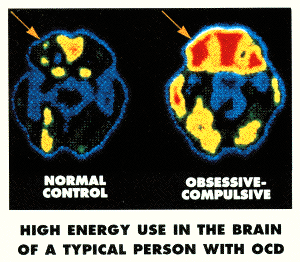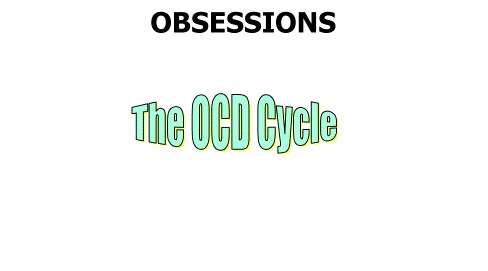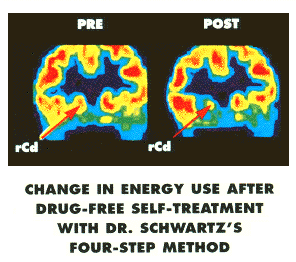Facts About OCD
Obsessions and Compulsions in OCD
About Obsessions
Obsessions are unwelcome and distressing ideas, thoughts, images, or impulses that repeatedly enter your mind. They may seem to occur against your will. They may be repugnant to you, you may recognize them as senseless or excessive, and they may not fit your personality.
- Recurrent thoughts, images, or impulses experienced as intrusive and inappropriate, causing marked anxiety or distress
- Not simply excessive worries about real life problems
- Accompanied by efforts to ignore, suppress, or neutralize thoughts
- Recognized as the product of one's own mind
About Compulsions
Compulsions, on the other hand, are behaviors or acts that you feel driven to perfom although you may recognize them as senseless or excessive. At times you may try to resist doing them but this may prove difficult. You may experience anxiety that does not diminish until the behavior is completed.
- Repetitive behaviors and mental acts that the person feels driven to perform in response to an obsession or according to rigid rules
- Aimed at preventing or reducing distress or preventing some dreaded event or situation clearly excessive or not realistically connected to the obsessive fear PET Scan
Diagnostic Criteria for OCD
- At some point the person has recognized that behaviors are excessive or unrealistic
- Obsessions and compulsions cause distress, are time consuming, and significantly interfere with functioning
- The content of obsessions and compulsions cannot be accounted for by another disorder
PET scans indicate differences in brain activity of OCD patients versus normals

Epidemiology
- OCD has a one-month prevalence of 1.3%
- OCD has a lifetime prevalence of 2.5%
- Four millions adult Americans have OCD
Factors contributing to underestimation of OCD prevalence
- Patients resist disclosing 'crazy' symptoms
- Failure to screen for OCD during MSE
- Difficulties in differential diagnosis
Compulsions
Common Compulsions
- Checking
- Washing and Cleaning
- Repetition of Normal Activities
- Ordering or Arranging
- Saving or Collecting
- Mental Compulsions
- Special words, images, and numbers recreated mentally to reduce anxiety
- Repetition of special prayers
- Mental counting
- Mental list making
- Mental reviewing
Incidence of Compulsions by Percentage
- Checking: 28.1%
- Cleaning/Washing: 25.9%
- Mental: 11.5%
- Repeating: 11.0%
- Ordering/Arranging: 5.3%
- Hoarding/Collecting: 3.2%
- Counting: 2.6%
- Miscellaneous: 12.4%
Obsessions
Common Obsessions
- Contamination: Dirt, germs, bodily waste, chemicals
- Mistakes: Locks, appliances, paperwork, decisions
- Impulses: Violent, sexual, religious, embarrassing
- Order: Neatness, symmetry, numbers
Incidence of Obsessions by Percentage
- Contamination: 32.9%
- Aggression: 16.6%
- Need for Exactness: 8.5%
- Religious: 6.3%
- Somatic: 6.2%
- Sexual: 5.3%
- Hoarding/Saving: 4.0%
- Miscellaneous: 20.2%
Obsession-Compulsion Relationship
Compulsions may fall into any of the following categories:
- Are intended to prevent harm
- Have nothing to do with harm, they just reduce discomfort
- Are done automatically without purpose
- Relationship between obsessions and compulsions is unclear
OCD is Reinforced by Learning
- Obsessions give rise to anxiety or distress
- Compulsions reduce obsessional anxiety
- Performance of compulsions prevents the extinction of obsessional anxiety
- Compulsions are negatively reinforced by the brief reduction in anxiety they engender
The OCD Cycle
The picture below represents the typical cycle of a person suffering from OCD. Obsessions cause anxiety, causing the sufferer to engage in compulsions in an attempt to aleviate the distress caused by the obsessions. Carrying out these compulsions, or rituals, does not result in any permanent change, and in fact, the OC symptoms worsen.

Comorbid Conditions
Incidence of Comorbid Conditions
- Depression: 30%
- Simple Phobia: 30%
- Social Phobia: 20%
- Panic Disorder: 15%
- Tourette's Syndrome: 36-52%
- Sleep Disorder: 40%
- Eating Disorders: 10%
- Bulimia: 33%
More about OCD comorbidities.
Effective Treatments for OCD
There are many effective treatments for OCD, alone or in combination. However, behavioral therapy produces the best and most durable results.

- Drug Therapies
- Behavioral Therapy
- Medication with Behavioral Therapy
PET scans of OCD patients show the same reductions in brain caudate nucleus activity (center of brain) that occur following successful drug treatment are also produced by successful behavior therapy.

